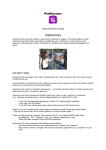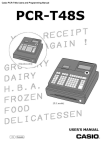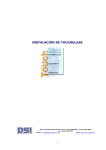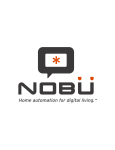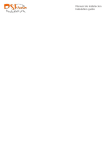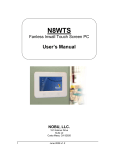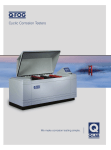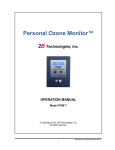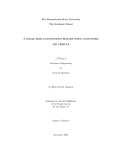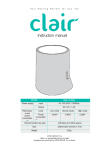Download rpvs TouchGlass
Transcript
rpvs TouchGlass 1 TouchGlass Makes windows & panels interactive Easy to install Available up to 100” (16:9) and 80” (4:3) image size rpvs TouchGlass Above picture is TouchGlass and dnp Holo Screen TouchGlass turns any window or panel into an interactive display. It fits behind glass or sheet material being used without any drilling or additional work. Installation is quick and easy with temporary and permanent options. The product is reliable and is used successfully throughout the world. HOW DOES IT WORK? ▲ TouchGlass is actually a thin, clear, flexible plastic foil, with a matrix of tiny wires inside, almost invisible to the eye. ▲ TouchGlass is combined with rear projection screens, front projection screens, LCD panels, printed panels etc to create your own interactive display ▲ TouchGlass works by ‘projected capacitance’ – an invisible field that detects a finger location with great accuracy (even if you have a glove on). ▲ TouchGlass works through non-metallic sheets (e.g. glass, acrylic, wood etc), transparent (e.g. windows) and opaque (e.g. a printed display board) up to 16mm (0.63”) thick. • It can work through double-glazing up to 25mm (1”) (special option available). • It will work with LCD panels. • It will NOT work with plasma panels (they produce too much EM interference). ▲ There is a tiny bar containing the control board mounted to one side of the main plastic sheet. • (This can be on any side, and is usually hidden by a sticker or other panel.) ▲ There is a cable from the controller which leads to the PC via a standard RS232 serial cable • (Standard 6m—19.6’ . Options to 15m—49’; boosters required over 15m). • TouchGlass takes its power from this RS232 connection. ▲ TouchGlass comes complete with Windows driver software. • All normal mouse functions can be generated (click, double click, drag etc). • Runs normal software, navigates web sites and specialist applications (e.g. Touch24/7 or your own). 1102 E Washington Avenue, Santa Ana, CA 92701 Phone 714-550-7211▲ Fax 714-550-7230 2 rpvs TouchGlass Specifications Detection Method: Screen Sizes: Projected Capacitance technology using horizontal & vertical wires. 30”- 80” in 4:3 aspect ratio. 30”- 100” in 16:9 aspect ratio. Other sizes available on request. Fixing options Removable and permanent options available. Position accuracy: Approximately 3 mm absolute, 1 mm relative. No drift. Alignment: Software driver provided has full calibration functions. Can be programmed for different thicknesses of glass and for use with Sensitivity: gloved hands. The standard product is configured for use with non- metalized single construction glass up to 16mm (0.63”) thick. Double glazing option up to 25mm (1”) available (see notes below). Speed of response: Connection: Software Compatibility: Typically 50 to 100ms -depending on material thickness. RS232C communications via standard 9 pin serial connector. USB option available. All units supplied with Windows driver software (compatible with all Windows versions, including Vista). Linux driver also available. Temperature range: Better than -10 to +70°C Humidity Controller: 0% to 95%. Unaffected by condensation. Light Transmission: Typically better than 85%. EMC EN55022:1998 + A1 + A2 EN55024:1998 + A1 + A2 This device complies with Part 15 of the FCC Rules Operation is subject to the following two conditions: (1) this device may not cause harmful interference, and (2) this device must accept any interference received, including interference that may cause undesired operation. Double glazing notes. With double glazing we recommend using only the touch (i.e. not the touch and drag) function in the software driver. The drag function becomes limited because we have to reduce the system scan rate when working through thicker materials. Double glazing can vary greatly in construction - so we always recommend doing tests before you place an order. 1102 E Washington Avenue, Santa Ana, CA 92701 Phone 714-550-7211▲ Fax 714-550-7230 3 rpvs TouchGlass Interactive Foils FAQ What is the Rp Visual Solutions Interactive Foil? Rp Visual Solutions’ interactive foil is a clear lightweight touch foil that can be applied under or behind any non-metallic substrate to create a through material (glass) touch system. How does it work? The Rp Visual Solutions’ touch foil uses projective capacitance. When a user’s finger or gloved hand comes close to the surface it causes a deflection in the electrical field. This deflection is registered by ultrafine wires in x and y axes, allowing precise location of the touch position. What thickness of material can the touch foil work through? The touch foil can work through non-metallic materials up to 16mm (0.63”) thick. We do recommend testing materials thicker than 10mm (0.4”). Will it work through double-glazing? The touch screen can work through double-glazing. To achieve this the con- troller board has to be modified in the factory. This modification slows the refresh rate of the touch screen. Due to this only touch functions are available in this mode rather than drag and touch. We recommend site testing in all cases to check functionality since double glazing specification vary widely. What are the typical uses of the interactive foil? Through-window system using rear projection or LCD as the display technology. Integrated with LCD displays for creating kiosks or stand-alone touch screens. Under table tops for using LCD or projectors from above for the display technology. What sizes are available? The foil comes in standard 4:3 format from 30" to 80" and 16:9 format from 32" to 100". Special custom sizes are also available. What is the largest foil size I can buy. The width is 120 cm (47.2”) and length is 220 cm (86.6”). Please call Rp Visual Solutions to discuss requirements. How is it fixed? The touch screen can be fixed using either a permanent or non-permanent adhesive system (a sheet of clear ma- terial), dependent on the application. The non-permanent system is designed to be for used on glass only and is ideal for retail applications to allow frequent application and removal. Our permanent system uses an optically clear system ideal for applying to glass and other non-metallic sub- strates. This is also the better option for more rugged applications. Both systems use an easy wet lamination process. (You wet the glass with a spray, apply the foil, then use a squeegee to squeeze out excess water.) Full laminating instructions are available. Will the touch foil work through K Glass? This type of glass uses a metal in the manufacturing of the glass so the touch foil will not work through this material. Other metal tints also stop the foils working. What are the key benefits of the Rp Visual Solutions’ interactive foil? No mechanical wear as you are not touching the touch screen unit - only the substrate it is working through. Works through existing windows/glass Lightweight foil easy to apply to a range of materials glass acrylic wood etc. Easy to ship rolls up in a tube 1102 E Washington Avenue, Santa Ana, CA 92701 Phone 714-550-7211▲ Fax 714-550-7230 4 rpvs TouchGlass Interactive Foils FAQ cont. Will it work with LCD panels? The touch foil can be used with LCD displays. As a through window touch unit the touch foil is first applied to the window and then the LCD unit is fixed behind the touch foil. Can it be integrated completely within an LCD panel? Yes! The foil must be applied to a substrate. There is typically a requirement for an 6-8mm (0.24” - 0.8”) air gap between the LCD panel and the back of the touch foil; this gap is dependent upon the EM noise generated by the LCD panel. It is also necessary to ground the controller unit to the case of the LCD unit. Will it work with plasma panels? No. These displays generate too much electrical noise Does the foil have a front and a back? The foil does not have a front or back, However when the unit is supplied with a integrated double release fixing system the foil is applied on one side only. It is also possible that the touch foils will need to be insulated from each other Must the controller board be at the bottom? No. The unit can be applied with the controller at the top or bottom. The foil can also be supplied with the controller on the side. Can I use cling film with acrylic (e.g. Perspex)? For a short period only. Over a longer period the cling film will ‘migrate’ into the acrylic making a permanent bond with the acrylic. How long is the serial cable? Standard cable supplied is 6m (19.6’). We also have a 15m (49’) cable as an optional extra. Can I have longer cables? It may be possible to use up to 25m (82’). However you may experience additional noise/interference, which can make the system unusable. In these situations we would recommend the use of a suitable RS 232 booster or a RS 232 to Cat5 converter system. How do I connect to a USB computer port? You can use a USB to serial converter device which are available as an op- tional extra. What is the power required for the touch screen? The touch screen is powered from the RS232 port and takes between 5-12v. Can I have 2 foils next to each other? Yes and no! It is not possible to have two touch foils on the same piece of glass There is a requirement to have an air gap between two foils It is also possible that the touch foils will need to be insulated from each other Can I use foils with other substrates, for example wood for interactive tables? Yes, the touch foil can work through any non-metallic material. We strongly recommend testing of the substrate to check the functionality. My calibration points are outside the display area, can I adjust this? Yes, we can provide instructions on how to do this. The touch foil is not responding, how do I check what the problem is? Please refer either the quick start guide or full user manual for fault-finding instructions. How do I use the cling film? Laminating instructions are supplied with the touch foil, they can also be found on the CD supplied with the touch foil. 1102 E Washington Avenue, Santa Ana, CA 92701 Phone 714-550-7211▲ Fax 714-550-7230




